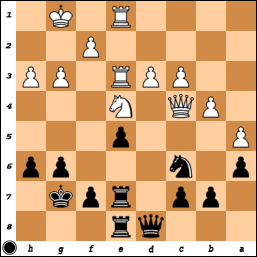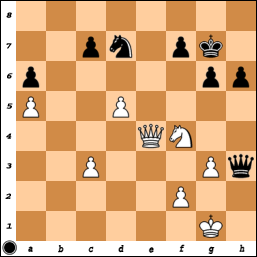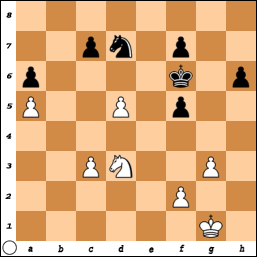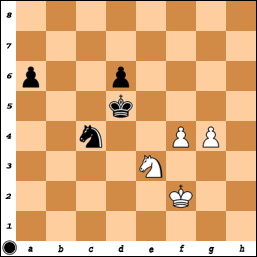Here is the game with my annotations from shortly after the event.
Thoughts from someone who still can't quite believe that he talks about chess for a living
Sunday, December 30, 2012
Year End Wrap Up: 2002
Here is the game with my annotations from shortly after the event.
Friday, December 21, 2012
Tonight's Lesson - A Story
I decided today to teach one my students a lesson on the bishop pair. For the first example I started with one of my tournament games, which had reached the following position with black to move. What would you play?
After considering many options, this student decided on 1... Rg8! This was the move I played in the game. I consider it the most logical choice in the position. (You could argue that 1... Qxh3+ 2. Kg1 Bxg2, is as good, but in that case you are probably a computer, because position looks much complicated to me than the game continuation.) The kid had worked out how 2. Bf6, maybe white's most natural looking move, loses spectacularly to 2... Qxh3+ 3.Kg1 Rxg2! 4. Nxg2 Bd4! and white gets mated on g2!
Instead of allowing mate, the game continued 2. Qf5+ Qxf5 3. Nxf5, leading to the next diagram with black to move. What would you play?
The student thought for a few minutes in this position. He nearly grabbed his c6 bishop to play Be4 or Bd7, both tempting moves that don't improve black's position (White has Nd6 and e6 respectively as responses). I figured that he would most likely follow my play in the game and choose 3... Rxg7. Black would have two bishops against a rook and pawn, which in this case can easily be converted into a win. My version of Fritz evaluates that position as nearly two pawns in black's favor.
Instead, my student played 3... Bxe5!? I hadn't remotely considered this possibility during the game, but it turns out to be just as good. Furthermore, it is much more spectacular than my decision! Our training game continued 4. Bxe5 Rxg2 5. Nd4 (5.Rf1 lets black carry out a classic windmill tactic - 5... Rxa2! 6. Kg1 Rg2! 7.Kh1 Re2+ and black will win easily.) 5...Rc2+ 6. Nxc6 Rxc1+ 7. Kg2 Rc2+ 8. Kf3 a5... Black will soon capture on a2 and promote one of his queen-side pawns.
You can follow this whole game fragment below:
Sunday, December 16, 2012
DC Chess League: December Edition
My opponent played pretty well and I made a couple mistakes, so the game was roughly even until move 34 (pictured below) when he was overly hasty with the move a4. He didn't think long on this move because attacking my a6-c4 pawn chain is a normal idea, but he missed a couple tactical details that let me pick up a pawn. I think he became discouraged after losing the pawn and blundered twice more before resigning the game.
Saturday, December 15, 2012
Titled Player's Can't Play Endgames (Part II)
Wednesday, December 12, 2012
Grandmasters Can't Play Endgames (Part 1)
Sunday, December 9, 2012
Move First Think Later
The book isn't just a work of chess philosophy. My favorite chapter so far was a fantastic lesson on line-clearing sacrifices. The two diagrams below are a simple line clearing tactic and a much more difficult one. The first tactic is from one of my hundred or so games while entertaining kids at a tournament yesterday. The second tactic is from the book and much harder. I eventually stumbled on the answer, mostly through trial and error. Please leave solutions in the notes:
Question 1: Black to move and win:
Question 2: What is the best move for white?
Sunday, December 2, 2012
My Childhood Simul
I recently remembered a childhood game of mine from 2002, where I was on the other side of the simul tables. I played against Grandmaster Alexander Goldin, a multiple time winner of the World Open Chess Tournament. I played very badly in the opening, probably just not taking my opponent's threats into account. Somehow though, he let me stick around and then made a typical simul over-site to actually give me an advantage. I think that another player also got a draw and GM Goldin won the rest of the games. Probably no one got donuts that time either. I think that there is still a lamented copy of this score-sheet somewhere in my parent's home in Madison.
Here is the game with my original annotations from shortly after playing the game. Calculation errors and spelling errors are reproduced as they were.
Friday, November 30, 2012
All Rook Endgames Are Drawn?
Monday, November 26, 2012
When Openings Matter
Saturday, November 24, 2012
Thanksgiving Trip
Two games went quickly, with opponent's dropping material early on.
One game followed my favorite simul formula: The opponent let me play Bg4, to pin his king-side knight. Eventually I was able to play Nd4 and take on f3 to destroy the pawn wall in front of his king. My opponent defended better than my normal elementary school opponents do, but eventually I was eventually able to mate on g2 in the whole that his pawns had created.
I played the Pirk in one game and immediately regretted it because white has a dozen paths to a safe position there. Fortunately, white sacrificed two pieces for a rook and eventually lost another exchange. Converting the extra piece was straightforward.
The game I was most concerned about was against the 1850 rated adult. The last time we had played in a tournament game I ground out a win in tough fight. Somehow, despite finding myself out of book by move 3 (1. e4 e5 2. f4 d5 3. Nf3!?), this game went very smoothly and he resigned right before I was going to promote a pawn.
I failed to complete the sweep because my brother Daniel, also a graduate of West High, played the exchange variation against my French Defense. In the past Daniel never studied chess seriously, but still reached around 1800 when he was still playing 7 or 8 years ago. I never managed to get more than a slight advantage in the nearly symmetrical positions we had all game, and I was even lucky to hold a draw in the king and pawn endgame.
In the most exciting game of the day I had white against a promising young player. This game is a good example of the challenges of simul-play. I got a great position out of the opening, but missed the tactic that could have given me a quick win. Instead, I entered tactical complications that didn't work out, and suddenly I was worse. Fortunately, my opponent went for an endgame instead of playing for mate and I ended up with the largest pawn phalanx I've ever had. A few days after the game was played I tried my best to recreate it from memory. I'm sure there are a few mistakes, but you can play through the game below.
Sunday, November 18, 2012
For Michael Corallo
Thursday, November 15, 2012
Puzzle of the Day
Tuesday, November 13, 2012
Brooklyn Castle
My personal connection is that I received some career advice when looking for chess jobs from one of the film's stars, Elizabeth Vicary (now Elizabeth Spiegel). Also, one of my co-workers at Silver Knights has a brief cameo in the background.
Here's a link with more info: http://www.brooklyncastle.com/
Monday, November 12, 2012
Monday Calculation Practice
Sunday, November 11, 2012
Waking up from Hibernation
If you have any ideas for material to help keep Minor Pieces up and interesting please leave a comment.
Thursday, July 5, 2012
On Hiatus
Wednesday, May 30, 2012
Congratulations to Vishy Anand
Wednesday, May 23, 2012
College Days
Tuesday, May 22, 2012
DC Chess League Final
Sunday, May 20, 2012
Finally, Someone Wants to be World Champion
Wednesday, May 16, 2012
Another Queen's Gambit Trap?
Sunday, May 13, 2012
Grandmasters
Monday, April 30, 2012
Oy Vey
http://chessbase.com/newsdetail.asp?newsid=8115
Thursday, April 26, 2012
Pre-World Championship Contests
Saturday, April 21, 2012
Gelfand-Anand 2012
Tuesday, April 17, 2012
Puzzle Solutions, IE the Full Game
Monday, April 16, 2012
Chess Xtreme
http://www.chess.com/forum/view/general/xtreme-chess
Saturday, April 14, 2012
Something to Blog About
On Friday night I played in the DC Chess League against "Chess Xtreme" Star Kevin Wang. He's high school student rated 2331 and a pupil of GM Larry Kaufman, who may end up being my next opponent in the league. I equalized out of the opening, but gradually got into trouble during the middle game. My position was bad enough that the other team consulted and decided to take a draw on the next board, assuming that I would lose the game and the match. Things turned around in a bad knight ending, when he failed to take advantage of a better structure and let me eliminate his last remaining pawns. I haven't done an exhaustive analysis of this game yet, but I did pull out a few interesting positions, which can be used for training. These aren't necessarily tactics, just "What's the best move for white or black?" type puzzles. Please put answers in the comments. I will post solutions on Tuesday.
I had black in the position below. I played Qc8, eyeing h3 and protecting b7. This move is OK, but still leaves white better. There’s a more active try that I didn’t even consider. Can you find the best move for black?
Virtually everything about this position favors white. He has the safer king and better pawn structure. What’s the best move for black to get some saving chances?
White has a substantially better pawn structure in this endgame despite black’s more centralized king. This should be a close to decisive advantage, but my opponent’s next move might have thrown away the win. Can you do better for white?
At around one in the morning I reached the following position. What should black play?
Sunday, April 8, 2012
Saturday, April 7, 2012
Fun Blitz Game
Monday, April 2, 2012
King's Gambit RIP
Sunday, April 1, 2012
Good Times With the Traxler
Monday, March 26, 2012
Meeting the ICC Stars
Wednesday, March 21, 2012
A Sicilian Exercise

Although I started my chess life playing sharp e4 openings, like the King's Gambit I never bothered to learn the main lines of the Sicilian. I played the closed Sicilian at most opportunities and occasionally tried out 2. c3. In high school I mostly switched over to closed openings and left the Sicilian behind except for an occasional experiment with black (I drew FM Andrew Karklins, but also drew a seven year old). Nowadays I'm usually afraid to venture into these waters in high stakes games, but I occasionally use the Sicilian to get some calculation practice in training games. This was the case today when I played a G/30 against a friend. As one might expect from someone without Sicilian experience, I got a good position out of the opening, but had no feel for how to play the attack and made an unsound sacrifice. With both players getting low on time, I reached the above position with white to move. Before scrolling down you may want to ask yourself, "What would you play and What's the evaluation of the position"
Tuesday, March 20, 2012
Friday, March 16, 2012
Chess is Hard
Saturday, March 10, 2012
Long Night at the Office

Last night's DC Chess League match was a home game, so it was literally at the Office. I looked up my opponent, Andrew Samuelson, before the game and found some improvements on his previous games in the database. Unfortunately, his improvement came on move 5 and I started killing lots of clock time on mediocre moves. After I played 14... b6?, reaching the diagram above, the position became critical. Once the opponent fixed my weakness with 15. Ra6! I realized that I was going to lose the a-pawn by force because while can quickly get three pieces to the a-file.
Tuesday, March 6, 2012
I Should Make All My Classes Watch This

http://www.youtube.com/watch?v=S1HUlTKvDUI
Sunday, March 4, 2012
Missed This in a Blitz Game
Friday, March 2, 2012
Combining Work and Pleasure
Thursday, March 1, 2012
Guest Column
Tuesday, February 28, 2012
Troubles of a Chess Teacher
Thursday, February 23, 2012
Game of the Weekend
In round four I played against IM Marc Tyler Arnold. He is a 19 year old who already has one GM norm and a FIDE rating over 2500. I expect him to get the GM title sometime this year. I’m not sure how people like to see games, so I’ve included an annotated version here if you want to play out the game with a real chess board, and a PGN version below it where you can click through online. It’s hard to edit in Chessbase, so the text format is probably nicer.
USATE (4), 19.02.2012
[Kane,Jeremy]
Throughout the round it looked like my team was winning the match, but eventually we lost on boards two and three with a draw on board 4. The positive looking match situation affected the course of the game, making me overly eager to draw and Marc overly reluctant. 1.d4 Nf6 2.c4 e6 3.Nc3 Bb4 4.Nf3 b6 Last month I faced c5, which is the other main move. That game is annotated elsewhere on the blog. 5.Bg5 h6 6.Bh4 Bb7 Now I had to think for a bit. I have a book that recommends Nd2 here, but I don't have much experience there, so I transposed to what would have happened if black had played g5 before Bb7 anyway. 7.e3 g5 8.Bg3 d6 In my experience black usually prefers Ne4, so I wanted to check if there was a refutation. I spent 10 minutes trying to decide if Qa4+ wins a piece (it doesn't). Then I continued with normal developing moves. 9.Qc2 Nbd7 10.Bd3 Qe7 11.0–0N Marc said that this was the first new move of the game for him. I was attracted to it because I concerned about allowing black to grab the g2 pawn with g4 and Bxg2. Now my king is somewhat vulnerable, but harder to attack than it may appear. 11...Bxc3 otherwise the bishop will be trapped after Nb5. 12.bxc3 0–0–0 [12...Bxf3 This looks scary for white, but eventually the bishop pair and big center should matter more than the exposed king. 13.gxf3 h5 14.h4 gxh4 15.Bxh4 Rg8+ 16.Kh1 Black can't really get any attackers at the open white king.] 13.e4 Nh5 14.a4 It's useful to push this pawn as part of an attack, but also simply to try to trade off my isolated pawn. 14...a5 15.Nd2 e5 16.Rab1 Nf4 I'm not sure if I really need to eliminate the knight right away, but it seems like a better pieces right now than my bishop. 17.Bxf4 gxf4 18.f3 So far the position is double edged but roughly even. After the game my opponent suggested c5 as a way to completely block up the queenside. As long as a night protects b6 then it's hard to see how white can break through on the queenside. Instead, he came up with the positional plan of Bc6 and Qf6 which would force white to play d5 and block up the position. Fortunately for me, white can strike first. 18...Bc6? [18...Rhg8] 19.c5! At the cost of a pawn I let my bishop and knight use the c4 square and black's king comes under fire. 19...dxc5 20.Ba6+ Bb7 [20...Kb8 21.d5 Ba8 22.Nc4 Ka7 23.Bb5 Nb8 looks horribly passive for black.] 21.Bxb7+ Kxb7 22.d5 Ra8 This is ugly, but needed to defend the a5 pawn. 23.Nc4 Rhg8 He finds a good multi-purpose move to eye the white kind and defend along the 6th rank. 24.Qd3?! [24.Qb3 was suggested by black after the game. The plan is simply to play Qb5 and either capture with the knight on a5 or to bring the queen to c6. I would probably have played this way if I had remotely considered it as a candidate move. 24...Ra6 25.Qb5 Ka7 26.d6 cxd6 27.Rfd1 Rg6 28.Qc6 Nb8 29.Qd5± The two pawn deficit is not nearly as important as all of black's pieces being essentially paralyzed.] 24...Rg6 25.d6 I was overly hasty to cash in on my initiative. This move and the previous one allow black back into the game. [25.Rfd1 continuing to simply improve my position is better.] 25...Qe6 26.Rf2 cxd6 27.Nxb6?! This essentially forces a draw, but white could still have played for more. [27.Rfb2 Ra6 28.Rd1 Kc7 (28...Ra8 29.Nxd6+) 29.Nxe5] 27...Nxb6 28.Rfb2 Kc7 Based on the match situation black tried to keep the game going. [28...Ra6 29.Qxa6+ Kxa6 30.Rxb6+= would have probably been the end of the game if it were not a team event.] 29.Rxb6 Kd7 Black tries to get some winning chances by bringing the king to shelter on the kingside. 30.Rb7+ [30.Qb5+ Ke7 31.Rxd6 Qxd6 32.Qb7+ Qd7 33.Qxa8 Rd6 34.Rb7 Rd1+ would be a draw] 30...Ke8 31.Rb8+ [31.Qd5 I seriously considered offering a queen trade to try to take advantage of my active rooks. Even after some analysis, I'm not sure who's better in this position. Do any of you have thoughts on this?] 31...Rxb8 32.Rxb8+ Ke7 33.Qb5 Kf6 34.Qxa5 Kg5 35.Qd8+ Kh5 36.Qc8 Qa2 Neither side can keep their king safe long enough to make progress, so black offered a draw which I accepted. ½–½
Unfortunately, by this point my result was irrelevant from a team perspective as we scored only .5/3 on the remaining boards. I took a bye in round 5 and then we left for the 5 hour drive back before round 6. Overall I was quite happy with my 3.5/4 performance for the weekend, but with long drawn out games playing down and a missed opportunity playing up, I got a good performance review showing what to work on. For instance in just this game I made three mistakes common among lower rated players:
1. I was overly eager to make a draw when playing up.
2. I was uncomfortable being down material and hence too quick to simplify to a drawn position.
3. Doing post-game analysis with Marc, I could tell that he just saw a lot more than me during the game, including the key move Qb3, that might well have won. Speed and depth of calculation is probably still the main thing separating me from GM strength players like him.
Oh, well. It was a fun weekend. Now back to work.














